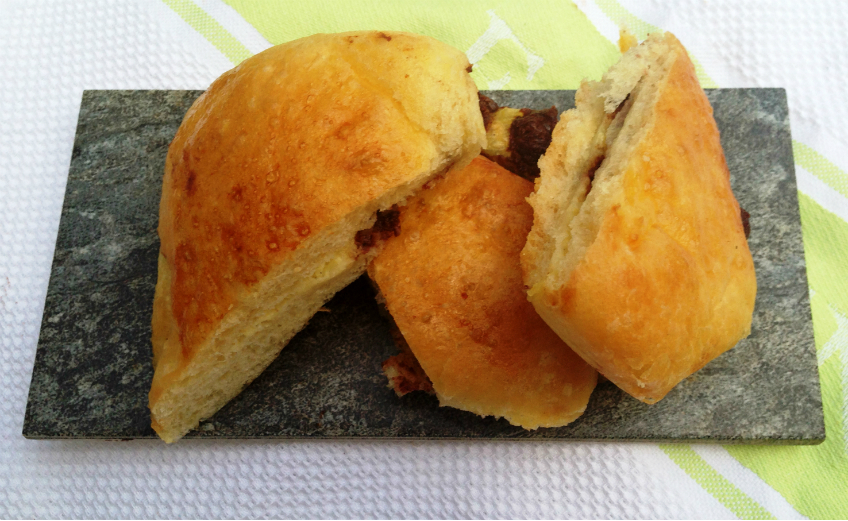
I have made brioche a couple of times using the recipe in ‘the book’, each time it felt like something was missing. The dough would prove well, but the finished result tasted artificially fluffy. On another occasion the bread would be lacking in flavour and all of the taste seemed to come from the creme patissiere and the chocolate.
I didn’t want to give in and be defeated by one of the most trendiest of breads, but I also didn’t want to try another recipe from the book, as they all used the same base brioche recipe.
So I took to twitter and asked if anyone could provide me with a tried and tested brioche recipe. In stepped Joe Bartlett from Ashburton Cookery School, with his own personal brioche recipe, that he uses on the cookery courses he teaches.
The recipe Joe provided me with was quite different to the one I had been using. The main difference was strong white bread flour, instead of plain flour was used. Another thing of note was the ratio of flour to yeast. The recipe in ‘the book’ had 10g of yeast for 250g of flour. Joe’s recipe had 12g of yeast for 450g flour. I don’t know nearly enough about the science behind bread and yeast, but I wondered if this could be the reason why I had textural problems with the brioche featured in ‘the book’.
The method was also different for Joe’s recipe, the sugar and butter were creamed together initially, almost like the beginning stages of a Victoria Sponge recipe. The yeast was also mixed with the warm water, before adding it to the dry ingredients.
After the brioche ingredients were combined in my food mixer, I needed to leave the dough to prove for two hours.
When I returned to the dough, I was greeted by a giant doughy monster…
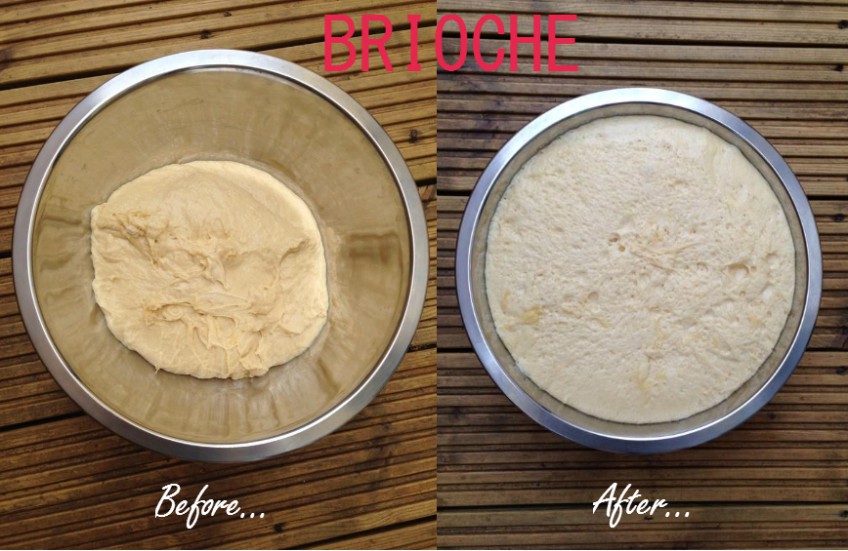
The dough needed to be ‘knocked back’ and then left in the fridge overnight or for a minimum of 12 hours. The reason the dough needs such a long resting time, is that it’s quite a sticky dough and it can be really hard to shape.
While my dough was resting I made a creme patissiere this would be used for the filling. I left the creme patissiere to cool in the fridge.
After the brioche dough had chilled overnight, it had risen a little in the fridge, I just squashed it down (technical term…), this is where I deviated slightly from Joe’s recipe. I rolled the dough out into a large rectangle about 4mm thick and spread half of it with creme patissiere and sprinkled on some chocolate chips.
It’s important to work really quickly with this dough, it comes up to room temperature quickly and can be really sticky and tough to work with as it warms. The dough is folded in half, encasing the chocolate and creme patissiere inside. I then cut the dough into rectangles and laid these on a baking tray lined with baking parchment.
These were covered lightly with clingfilm and left to rise in a warm place, not exceeding 30ºC for two hours or until doubled in size.
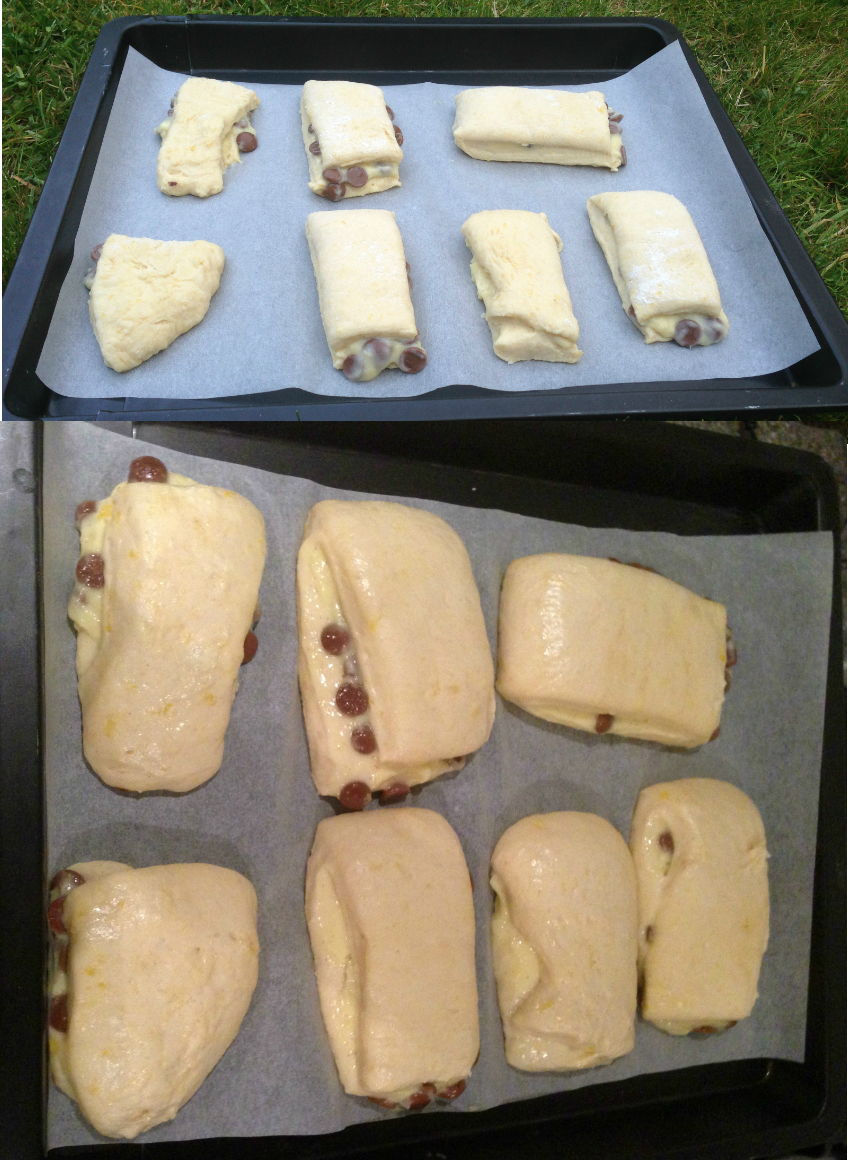
After this stage, the brioche are brushed with egg wash and baked in the oven for 15 mins at 200ºC until golden. Leave them to cool on a rack and eat them cold, or you can eat them warm, but let them cool down a little or you’ll burn your mouth, not that I speak from experience…
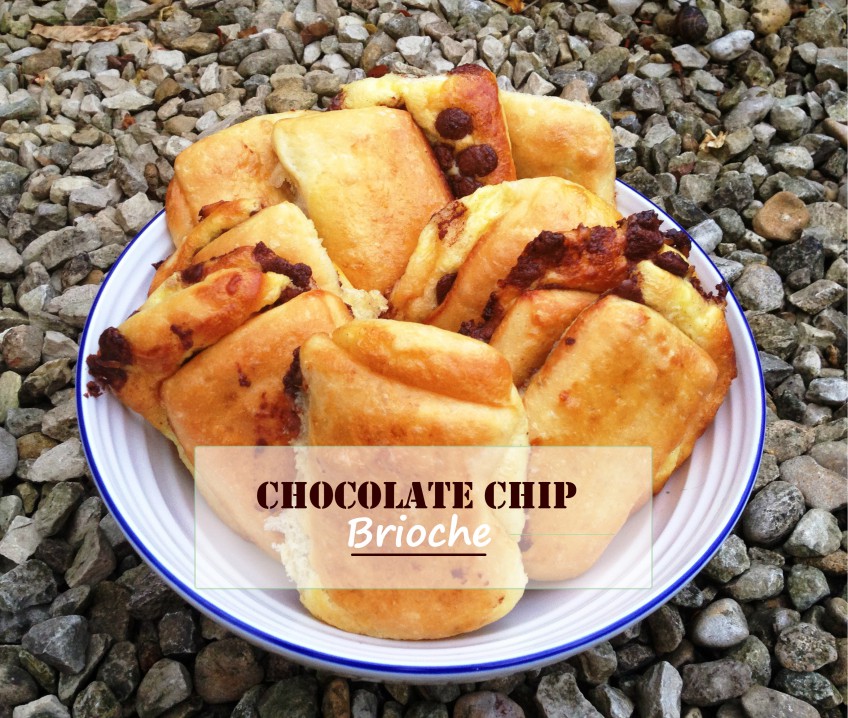
Here is the recipe for the brioche, so that you can try this yourself, it’s great for burger buns (used by nearly every trendy burger bar there is) or you can shape it into a loaf, just omit the creme patissiere and chocolate chips. If there are any leftovers, you can make an indulgent bread and butter pudding.
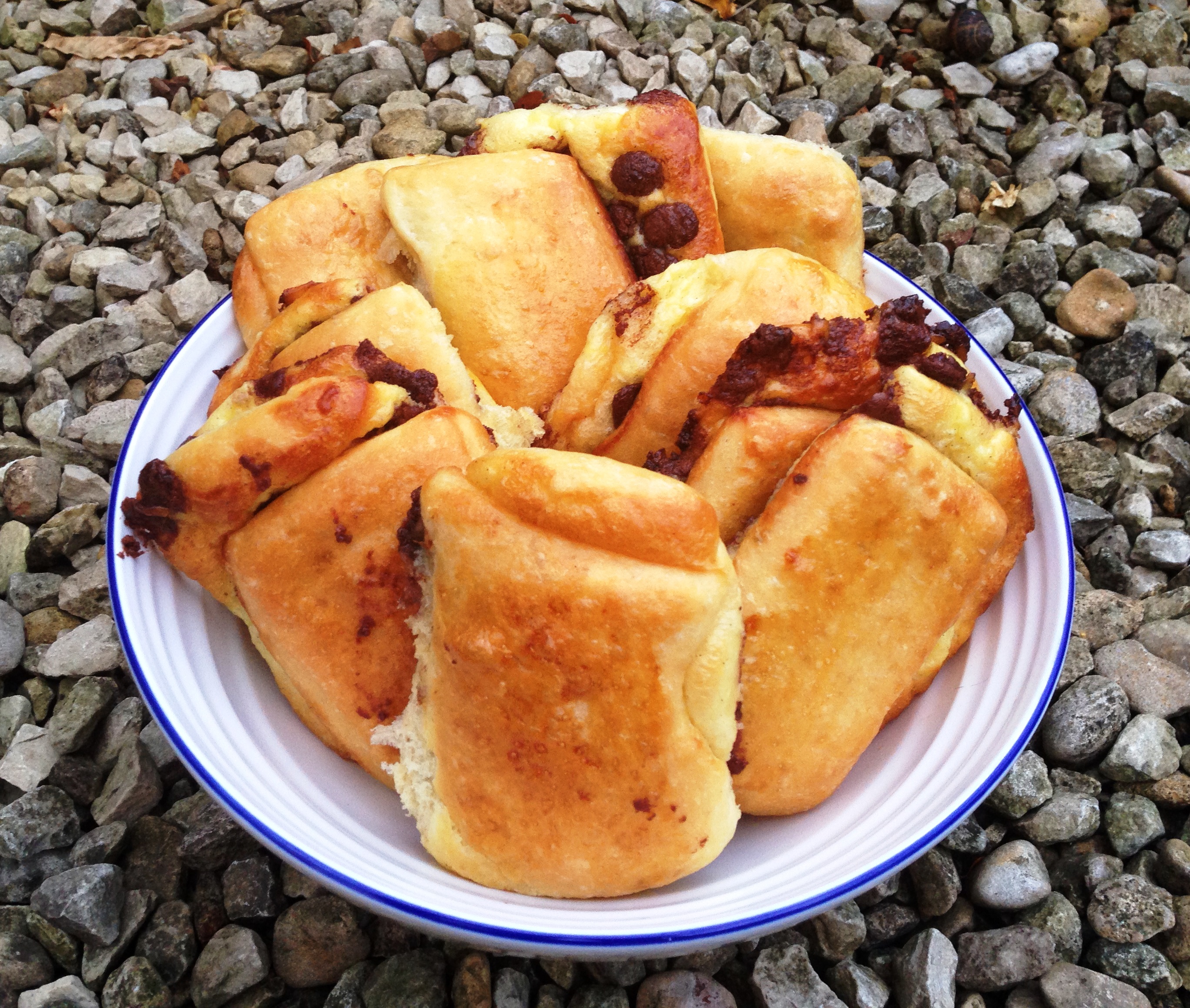
CHOCOLATE CHIP BRIOCHE
Ingredients
- 450 g Strong White Bread Flour
- 8 g Salt
- 12 g Fresh Yeast
- 4 Eggs
- 150 ml Lukewarm Water
- 30 g Caster Sugar
- 225 g Softened Butter
- 100 g Chocolate Chips
- **PASTRY CREAM**
- 1/2 Vanilla Bean
- 250 ml Milk skimmed/semi-skimmed/whole will all do fine
- 1 Tsp Unsalted Butter
- 2 Egg Yolks
- 50 g Granulated Sugar
- 20 g Corn Flour
- 1 Tbsp Plain Flour
Instructions
- Cream the butter and sugar together until soft.
- Mix the yeast with the warm water and a pinch of sugar and put this to one side.
- Beat the eggs together.
- Sift the flour and salt into the bowl of a food mixer and make sure that the dough hook attachment is fitted.
- Turn the mixer on to medium and add the yeasted water and the eggs to the dry ingredients.
- When the dough has started to bind together, start to add the creamed butter and sugar in small batches, continue to beat with the dough hook.
- When it is all mixed together and the dough comes away from the sides of the bowl, place it somewhere warm to prove for two hours.
- After two hours, knock the air out of the dough, wrap it in clingfilm and place it in the fridge for at least 12 hours or overnight.
- **NOW MAKE THE PASTRY CREAM**
- Split the vanilla bean lengthways and scrape out the seeds.
- Combine the milk, butter, vanilla bean and seeds in a saucepan and bring to a boil.
- Whisk the egg yolks with the sugar in a bowl until the sugar is mixed in and the mixture is quite pale. Then add the corn flour and flour.
- Strain the hot milk into the egg mixture, whisking constantly.
- Return the mixture to the saucepan and stir until the cream thickens.
- Remove the pan from the heat and scrape the pastry cream into a shallow bowl. Place a piece of clingfilm on the surface of the pastry cream to stop it forming a skin, then chill it completely.
- **BACK TO THE BRIOCHE**
- The next day, roll the dough out to a rectangle 4mm thick, you must work quickly, the moment the dough begins to warm up, it will be hard to work with.
- Cover half the dough in creme patissiere and chocolate chips, fold the other half of the dough over the top, cut the brioche into slices around 3cm wide.
- Leave to prove somewhere warm for two hours, until almost doubled in size.
- Then glaze with egg wash and then bake for 15mins at 200 degrees C, until they are golden.
Have you ever made brioche? Is your recipe or method different to this one? Or do you have a recipe that you swear by and you’ve tried another recipe and it’s not been as good? Let me know in the comments below.
Thanks for reading.
Angela

Aruna
Hi Angela, just stumbled upon this recipe and it looked perfect for what I was trying to do: brioche rolls with creme patisserie and dark chocolate & lemon. The rolls are resting for their final prove before baking. I am baking them in a muffin tin.
Very good idea to cream butter and sugar together. I wonder whether the method could be used to make croissants? Instead of the butter/dough lamination?
Thanks again 🙂
Jodie
can you send me a few of these please?! 😀 i’ve never had brioche and i can’t quite image the texture of a bread with the creme patissiere and chocolate. but i absolutely love the idea of using this type of bread for burgers or even sandwiches! so did this recipe turn out better than the previous ones?
patisseriemakesperfect
Jodie I’ll make these for you when you visit the UK. I’ll make you anything 🙂 Brioche is odd, but good. They use it a lot for burger buns here. I’m sure they do in US too. This recipe was much better. I’m very grateful to my twitter chef for help with this one.
Jodie
i really wish i could hop on a plane right now!! i’d be pretty hungry by the time i got there too. 😀 i’m quite sure brioche buns are used a lot here also. pretzel buns are quite the trend at the moment. still haven’t tried one of those although they look good. i’m glad this recipe was much better. twitter is such a great resource and your knowledge will only expand. how fun will it be to take what you’re learning from different sources and apply it across the board. lots of people will be turning to you for advice! 🙂 x
patisseriemakesperfect
Pretzel buns sound interesting. I’ve not made pretzels before. I am loving twitter for my baking, so many helpful folk out there.